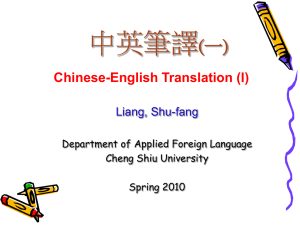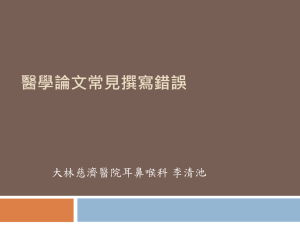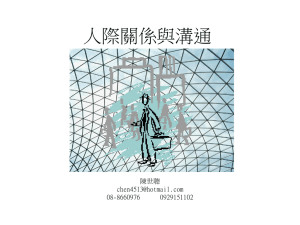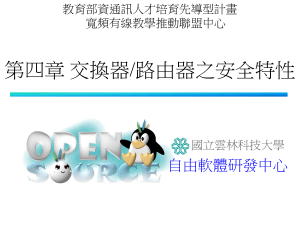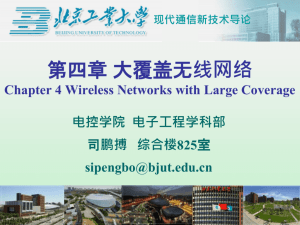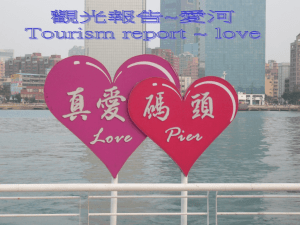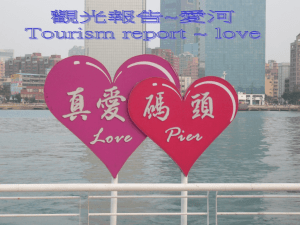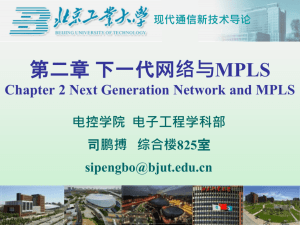考題類型
advertisement
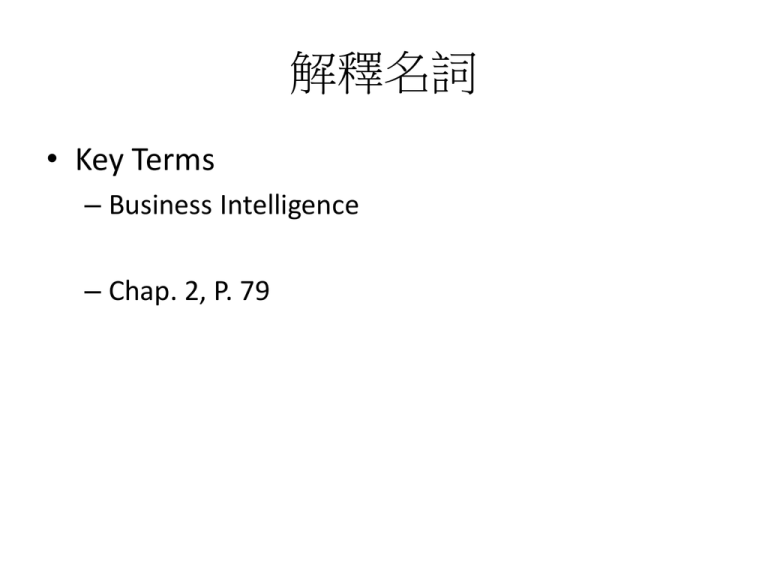
解釋名詞 • Key Terms – Business Intelligence – Chap. 2, P. 79 綜合題 • List three systems for linking the enterprise – Enterprise system (ERP) – Supply chain management systems – Customer relationship management systems – Knowledge Management systems – Chap.2, P. 81 • List the three interrelated changes in technology area of the new themes in business use of information systems • 列出管理資訊系統的新事件中,在技術領域有 三種互相關聯的變化 – The emerging mobile digital platform – The growth of online software as a service – The growth of cloud computing • P. 36, chapter 1 • 頁 7, 第一章 • List any 3 of Strategic business objectives of Information systems • 策略性企業目標 1. 2. 3. 4. 5. 6. Operational excellence New products, Services, & Business models Customer & Supplier Intimacy Improved Decisions Making Competitive Advantage Survival – – Page 42, Chapter 1 頁14, 第一章 • List the three dimensions of information systems • 列出資訊系統的三個面向 – Organizations – Technology – Management • P.48, chapter 1 • 頁22, 第一章 • List any 3 key organizational complementary investments which are required to optimize returns from information technology investments • 提高資訊科技投資 所需的互補性組織資產 – – – – – – Supporting organizational culture Appropriate business model Efficient business processes Decentralized authority Distributed decision-making rights Strong IS development team – P. 57, chapter 1 – 頁 33, 第一章 • List 3 typical business processes for the sales and marketing functional area of business – Identifying customers – Making customers aware of the product – Selling the product • P. 73, table 2-1, chapter 2 • 頁 49, 表 2-1, 第二章 • List the 3 components of DSS • 要素 – Data source • Internal: TPS, MIS • External: stock prices, competitor’s prices – Variety of MODELS to analyze data – User-friendly software (interface) • P. 78, paragraph 3, chapter 2 • 頁 55, 第二段, 第二章 • List the 4 Enterprise applications • 企業應用系統 – Enterprise systems – Supply chain management systems – Customer relationship management systems – Knowledge management systems • P. 82, chapter 2 • 頁 61, 第二章 • List any 3 collaboration and communication systems as vital management tools for jobs in today’s global economy • 協同合作與溝通系統 – – – – – – Internet-based collaboration environments E-mail and Instant messaging Cell phones and smartphones Social networking Wikis Virtual worlds • P. 90. chapter 2 • List 3 disruptive technologies • 顛覆性技術 – – – – – – – Microprocessor chips Personal computers PC word processing software World wide web Internet music services PageRank algorithm Software as web service • P. 113, Table 3-1, chapter 3 • 頁 96, 表 3-1, 第三章 • List the 4 dimension of organizational resistance • 組織抗拒 • P. 119, chapter 3 • 頁103, 第三章 • List the 4 generic strategies for dealing with competitive forces which is enabled by Information systems • 要使用資訊科技與系統才能發揮效用的四個一 般的策略 – – – – Low cost leadership Product differentiation Focus on market niche Strengthen customer and supplier intimacy • P. 124, chapter 3 • 頁 109, 第三章 • List the 3 building blocks of network-based strategies • 網路策略 – Network economics – Virtual company model – Business ecosystems • P. 134, chapter 3 • 頁 122, 第三章 • List the 2 companies which use data from multiple sources to create information on individuals • 從事個人資料蒐集的網際網路公司 – DoubleClick – ChoicePoint • P. 154, (profiling), chapter 4 • 頁 146, 輪廓描繪, 第四章 • List the 3 higher-order values • 更高層次的價值 – Freedom – Privacy – Protection of property – Free enterprise systems • P. 157, chapter 4 • 頁 149, 第四章 • List the 2 core principles of FIP • 核心原則 – Notice/Awareness – Choice/Consent • P. 161, chapter 4 • 頁 153, 第四章 • What legislation was established to regulate spamming in Europe and United States • 規範 -- 垃圾郵件 – Europe • ban on unsolicited commercial messaging – United States • does not outlaw spamming • ban deceptive email practices – P. 174, chapter 4 – 頁 170, 第四章 • List any four elements of the data hierarchy • 資料層級 – – – – – – – Bit Byte Word Field Record File Database • P. 237, chapter 6 • 頁 246, 第六章 • Develop an example to explain the multiple views of data within a database. • 多重觀點 p. 241, chapter 6 頁 250, 第六章 • What does the following query means? SELECT COUNT(DISTINCT AUTO.CUSTNUMB) FROM (AUTO, HOME, CUSTOMER) WHERE HOME.CUSTNUMB <> AUTO.CUSTNUMB AND HOME.CUSTNUMB = CUSTOMER.CUSTNUMB AND CUSTOMER.CITY = ‘Kaohsiung’; Note: <> means not equal. • The number of people in Kaohsiung city who has home insurance (火險) but not auto insurance (汽車險) • List the 4 types of information which is obtainable from data mining • 資訊類型 -- 資料挖掘 – Association – Sequences – Classification – Cluster • P. 256, chapter 6 • 頁 268, 第六章
